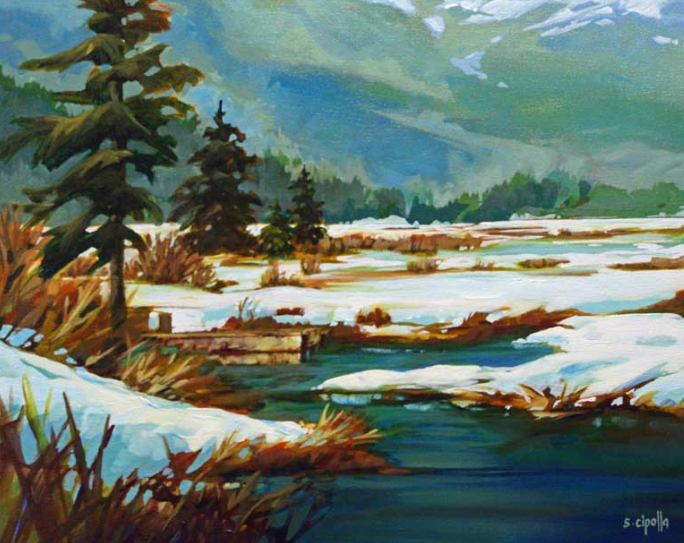
Duveen’s portrait was painted at least three times by his good friend the Swiss-born American artist Adolfo Müller-Ury
(1862-1947)
Archived Comments
Enjoy the past comments below for Immortality…
Thank you for your note on Joseph Duveen and the thoughts on immortality. As a painter, I feel that my work is improving, primarily through regular practice, astute observation, and a developing understanding of the world and my place in it. And I guess that is the question: the work I was doing five years ago (or ten, or whatever) was the best work I could do, then. I was proud of it, and it reflected what I had learned up to that point, and some of it went out into the world and paid for more paint and brushes and fostered more observation. I’d like to think that I am continuing to improve. But as a working painter, some of that work of five years ago, I now feel is substandard to what I am doing today (and some, with the benefit of hindsight, holds up quite nicely). How do you – how does one – decide what passes inspection? Let’s face it, there have always been more people painting than have achieved immortality. Most of us will not be discovered by the Duveens of tomorrow. Perhaps the difference between the Rembrandts and the rest of us is that they produced more zingers, more jaw-droppingly beautiful work. Or, could it be, that the work of some of the artists of the past that we know and revere today has only survived because some huckster decided he could make a buck by telling another huckster that it was good.
Many of the worlds religions offer some sort of an afterlife. The idea of somewhere better after we die seems to be built into our nature. Most of these heavenly places offer an abundance that may not be available in the religious persons current situation. Believers suffering from starvation, for example, tend to define heaven as a place where theres lots of food. One of the main reasons that many western religions are currently playing down the idea of an afterlife is because of the unfortunate example of some within the Muslim faith. When a fanciful vision of an afterlife is painted as being a bit too wonderful, and adherents are willing to take their own lives and those of innocent others in order to get there, then society at large is in danger. Temporal immortality would seem to be the better choice.
Extraterrestrial heavens are an ultimate human exclusivist conceit and are the vestiges of medievalism. Better to think about what can be accomplished for humanitys betterment in the here and now. We artists are in a prime position to do this.
Was that shred your sins, or shed your skins?
The woman you mentioned who will live on through her art without some sort of special dispensation from above is brave indeed. We need more of these unselfish people
So true. If a thing of beauty is a joy forever we need only concentrate on making things of beauty. Oh, and be nice to others.
I disagree with shredding the substandard work, future artists need to see our evolution (if they find us worth remembering at all) and struggle. Remember that today’s scribble on a napkin will be tomorrows prized valuable find, when we are long gone.
I wonder if the Brotherhood and Sisterhood of Artists that you so frequently mention is really evolved enough to realize that we hold the chance of immortality in our own hands. Very stimulating thoughts, Robert.
Heaven has indeed been played down from the few remaining pulpits in Germany. And the concept of Hell has all but disappeared now. This perhaps because of the imaginative depictions on cathedral walls and reredos of what things would be like if you had the misfortune and bad planning to get there. This was the old fashioned way of getting converts. Nowadays, Hell for a painter is not being able to paint. (translation)
How does one really know what is worth shredding or keeping when it is such a subjective process? I love many of my paintings, if I don’t love it, I don’t keep it. I do fear that my kids will have a huge bonfire as they prefer abstract, “modern” art that so far, I’m unable to produce.
Immortality is such a word that is used so loosely that sometimes it loses the real meaning of the word. Yes, great artists produced art that elevates them through their work some degree of immortality. People who view their work recognize the artist who did them through ages thus even through the generations the art of Leonardo da Vinci remember him as though he lives in his art. Great architecture elevates their author in seeming immortality. But does fame and memory interpret into immortality? I think immortality is more than. We might remember famous people through their work and achievement but they are not immortal. Art as in painting and other forms gives the artists an expression of their dreams, desires, inspiration and their spirituality. It may also give them fame but never immortality.
hmmm, if a man makes gazillion dollars selling snakes oil to the poor, and then donates half gazillion dollars and keeps the other half, does he deserve immortality? Examples abundant!
It is not the artist who achieves immortality. We become the dust in the next century’s colors. But the art I remind myself every time I send an art related message Art Lives Long. Artliveslong, D
The imortal can also be understood as simply non-biological coded information or expressions. Memes vs Genes. Where humans excel (or at least some of us) is by abstracting the internal mind of brainwaves through a non-biological medium – the external mind of art, literature, mathematics etc. Such richly coded artifacts remain simply another object in the world (such as in a museum basement) until yet another human brain comes along and similarly experiences the thing in new ways – thus converting non-living imortal artifacts into a living art residing temporally in the internal mind of the perciever. mark bruton greenwalt
We may give lip service to an afterlife, but we go about our lives as if it doesn’t exist. Thus has human nature evolved. Artists, including poets and writers, need to feel blessed that they can explore the edges of this mystery.
In historic times when a high percentage of people died young, or as they still do in some areas of the world today, then the idea of another life after this one is quite appealing. It’s not so necessary now, and we have more time to fulfill our dreams and be of service to others.
Not your dad’s Oldsmobile. In many cases where a huge value is not put on posthumous work, the next generation will have a tendency to reject it. Robert is right, you need to weed carefully so that keeping it will not be a difficult storage burden while waiting for another dispensation.
I paint my best today and leave immortality to the next generation to worry about. Afterall, there is little we can do then.
I picked up some of my early works from the walls of some family members. I thought they were horrible, but of course, many years have gone by and although my family said “Hey, where are you going with that painting”? I said, “I’m cutting it up for bookmarks and I’ll give you a new one”. Some of them said, “but I like it” and I said “but I don’t”. Definitely we should keep the good work, so when we are gone, our kids don’t start giving away all the bad ones. Now that I am good with acrylics, I am re-doing some works. It’s fun, especially if you leave some of the old work showing. Makes them three dimensional. Also, you can reinforce your work with a little bit of “a la Jackson Pollock” style. You also save a lot on new canvases. www.maritzabermudez.com
People have been trying to beat death since time immemorial. Interesting that Robert Ettinger, founder of the Cryonics Institute recently passed away, age 92, at his home near Detroit. His was the 106th person to be frozen by the institute in the hope that, at some future date, there will be some new technology to fix things and bring him back to life. As Woody Allen said, “I don’t want to achieve immortality through my work… I want to achieve it through not dying.”
Oh so true Robert!!! But they needed someone educated to tell them what to buy most of the time:)) Peggy Guggenheim did pretty well on her own:)))) The Moma still has the urinal right…even though they have been trying to sell that sucker:))) I watch the art world with amazement:))) fun stuff!!!
Do not understand all this emphasis on immortality, whether we speak of art or souls or memory. Not all cultures have this. The important thing is to live fully and gently in the here and now, participating in each moment. Immortality, whatever it is, will take care of itself.
People — don’t worry about what happens 2 ur art after U are gone — the kids — or grand kids — sell it all — on auction — usually. I’ve been told even family photos –albums full — show up at the thrift store — these genrations don’t seem 2 want — keep sakes — they throw everything out!!!!! so not 2 worry.
To Dayle Ann Stratton: You are wise. Your belief is simply, perfectly stated. Thank you.
Immortality is delusory, egotistical nonsense. Usually two generations and someone is all but forgotten. Work that lasts longer than that is signed by a stranger. What continues to live is the work, attached to which is a name which is a usually an empty shell for our imaginings.


Alta Lake Marsh acrylic painting, 16 x 20 inches by Susie Cipolla, Whistler, BC, Canada |














That Getty museum is what a building would look like if money were no object. It is truly amazing.